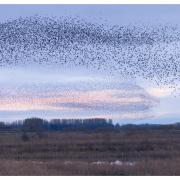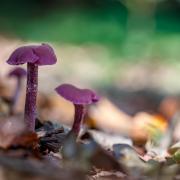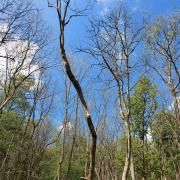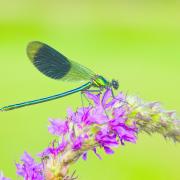What’s the buzz in York? Jo Haywood finds out

One in three mouthfuls of our food is dependent on insect pollination. And it’s not just fruits like strawberries and raspberries but also many of our vegetables, coffee and even chocolate.
Just think, you might not have had that chocolate Hobnob to dip in your tea this morning without the hard work of some nameless, winged little creature doing his (or her) buzzy business.
And, when they’re not providing a feast for our table, pollinators are providing a feast for our eyes by enabling 80 per cent of our wildflowers to bloom.
They are small wonders who make a major impact on our lives, but are we grateful? Perhaps not as much as we should be. There might be millions of insects in our midst but we find it all too easy to take them for granted, only taking any notice when they land on our fruit salad.

But now a pioneering pollinator project (try saying that with a mouthful of honey) is aiming to give us a new perspective on our small but significant neighbours by creating 100 Urban Buzz sites in York.
‘My goal is to create 100 buzzing hot spots in an area of around 25 hectares,’ explained Andrew Cutts, York’s Urban Buzz conservation officer. ‘I also want to engage with local people and enlist 600 volunteers to spread a positive message and keep the buzz going when it’s time for me to move on.’ (It’s an 18-month project; he’s heading to Leeds next).
There are 18 sites up and running already, including Door 84 (a youth club in The Groves), St Nick’s (an urban nature reserve owned by City of York Council), Millennium Bridge, West Bank Park, Danesmead Meadow, the University of York and Park Grove Primary School.
There have also been amazing changes in the Mosaic Garden in Heworth, where tireless volunteers from the Glen Mosaic Garden Group, St Nick’s and Blueberry Academy, which helps adults with learning difficulties improve their employment prospects, have created a beautiful wildflower meadow to encourage bees and other pollinators to take up residence.

‘Their hard work has made a dramatic change,’ said Andrew, as we joined the volunteers for a cuppa and a biscuit (one of Prince Charles’ nice ones). ‘They’ve shown people what can be achieved. Frankly, they’re amazing. Every time I come down here, I see something new.’
As if on cue, a fluttering squadron of butterflies descend on the flowers in front of us and a bee emerges from under a blossom and, looking slightly tipsy on nectar, buzzes off at a jaunty angle into the long grass.
‘In just this small section of the Mosaic Garden, there are more than 30 species,’ said Andrew, who’s originally from Sheffield and has a Masters in etymology. ‘There are 1,500 pollinating insects in the UK. I don’t know all of them, but I’m getting to know more every day.’
When you’re sitting in a garden literally surrounded by pollinators doing what they do best, it’s all too easy to forget that many species are in serious decline.
‘We can’t just sit back and let it continue,’ said Andrew. ‘Bees (the standard-bearer of the Urban Buzz message) are important for our food production and the health of our landscapes. Without them, a great many of our flowers and plants wouldn’t be back next year.
‘Their decline is down to many factors: climate change, the fragmentation of their habitat, intensive farming and over-use of pesticides. Simply putting in a road or cutting out part of a hedge can have a dramatic effect on the local bee population.
‘Things began to go downhill at the end of the Second Word War, when we changed the way we viewed our landscape and decided we needed two crops a year instead of one. This quickly led to species becoming more isolated and losing their natural connections.
‘Our great-grandparents would recognise the wildflower meadow we’ve planted here in York, but it’s something new for us and for the younger generation. I hope the work we’re doing now will mean, in generations to come, there will be more wild flowers and less decking in gardens. Even if everyone in York just installed a windowbox it would make a significant difference.’
The York Urban Buzz project, which is supported by City of York Council, York MP Rachael Maskell and TV adventurer Steve Backshall, was initially funded by Biffa Award, a multi-million pound fund that helps to build communities and transform lives through environmental grants, and recently received £5,000 from Yorkshire Bank through its Spirit of the Community Awards.
But a further £5,000 is needed to support more community events, like a recent Pollinators Day at Rawcliffe Park, which attracted more than 70 people who took part in bug hunts and other awareness-raising activities.
Andrew’s job is to get York buzzing about all pollinators but, on a personal level, he admits he thinks bees are, well, the bee’s knees.
‘Bees are amazing,’ he said. ‘They work so hard. And not just for themselves; for their families, their communities and for us. We have pollinators like bees to thanks for 84 per cent of EU crops, and we import 40,000 bumble bee colonies (that’s 40,000 colonies, not 40,000 bees) to work in our glasshouses.’
When his 18-month stint in York is over and the 100th buzzing hotspot is in full bloom, how will Andrew measure the success of the Urban Buzz project? (Presumably not by doing a head-count of the bee population.)
‘For me, it’s about the army of volunteers who’ll still be here when I’m gone,’ he said. ‘And it’s about creating a template here in York that we can use in other cities across the country. We’ll learn from our experiences, both positive and negative, and, while we can’t reverse everything, we can make a substantial difference.
‘At the end of the day, I feel we’re doing our bit to protect the little things that run the world.’
A bug’s life
So, what exactly do nature’s wild pollinators do for us?
:: Flies
Our love of chocolate relies on tropical flies to pollinate cocoa. And, here in Britain, we have roughly 275 species of hoverfly who visit 80 per cent of our garden flowers.
:: Moths
When everyone else is asleep, moths provide a pollinator night shift, visiting flowers like evening primrose, honeysuckle and summer jasmine. We have around 2,400 species in Britain, but as many as two-thirds of our larger moths have declined in the last 40 years.
:: Bumblebees
These busy buzzers are great pollinators of fruit and veg like runner beans, tomatoes and summer fruit. Unfortunately, of the 24 species in Britain, six are endangered and one species recently became extinct.
:: Beetles
Did you know that beetles pollinated the first flowers at the time of the dinosaurs (more than 140 million years ago)? Now, we have around 100 pollinating species, usually found on open flowers like magnolia, mallows and roses.
:: Solitary bees
They might be loners but they still like to get out and about, particularly in spring and early summer when they keep themselves busy pollinating our orchards. We have about 220 species in Britain and, before you ask, no, they don’t sting.
:: Butterflies
These aren’t just pretty and fluttery, they’re also useful flower pollinators, thanks to their long tongues that can reach down into species like scabious, honesty and lavender. We have about 60 species but, sadly, three-quarters are now in decline.
Want to bee part of it?
Everyone is welcome to join the Urban Buzz community of busy bees. Individuals, communities and volunteer groups can help create and maintain wildlife havens across York.
You can also nominate a publicly accessible space you think would make a great pollinator habitat.
At home, you can make sure there’s a diverse environment to encourage all manner of insects via trees, grass, wildflowers and maybe even a bee hotel (drill holes 3-12mm in dead wood to a depth of around 10cm; and, don’t forget, bees like a south-facing home).
If you don’t want to roll up your sleeves, you can opt to dig deep in your pocket instead and make a donation.
And, even if you’re short of money, you can always donate tools, plants and other handy garden bits and bobs.
:: For details of how you can do your bit, contact Andrew Cutts on 07464 828 626 or andrew.cutts@buglife.org.uk; visit buglife.org.uk/urban-buzz/york; or tweet @buzz_dont_tweet. You can donate directly at buglife.org.uk/donate-york or text ‘buzz14 £10’ to 70070.



























